
Persicaria maculosa is an annual plant in the buckwheat family, Polygonaceae. Common names include lady's thumb, spotted lady's thumb, Jesusplant, and redshank. It is widespread across Eurasia from Iceland south to Portugal and east to Japan. It is also present as an introduced and invasive species in North America, where it was first noted in the Great Lakes region in 1843 and has now spread through most of the continent.
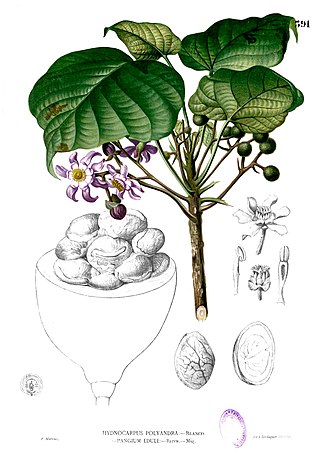
Achariaceae is a family of flowering plants consisting of 31 genera and about 155 species of tropical herbs, shrubs, and trees. The APG IV system has greatly expanded the scope of the family by including many genera previously classified in Flacourtiaceae. Molecular data strongly support the inclusion of this family in the order Malpighiales.

Baphia longipedicellata is a species of plant in the family Fabaceae. Subspecies keniensis is found only in Kenya and is threatened by habitat loss.

Bauhinia bowkeri is a species of legume in the family Fabaceae. It is a scrambling shrub or small tree found only in South Africa, where it is threatened by habitat loss.

Satranala decussilvae is a species of flowering plant in the Arecaceae family. It is a palm endemic to Madagascar. It is the only species in the genus Satranala, and is threatened by habitat loss. There are perhaps 200 mature individuals remaining.
Kraussia socotrana is a species of plant in the family Rubiaceae. It is endemic to Socotra, Yemen. Its natural habitats are subtropical or tropical dry shrubland and rocky areas. The type was collected from Wadi Irih on the Nogad Plain.

Kraussia is a flowering plant genus in the family Rubiaceae. Apart from a species in Socotra, they are native to continental Africa. The type was described from a plant collected by Dr. F. Krauss near Durban. It is differentiated from Tricalysia and Empogona by the ovule arrangement inside the ovary cells. The genus contains between 4 and 10 species, including:
Kraussia speciosa is a species of plant in the family Rubiaceae. It is found in coastal Kenya and Tanzania, where it is associated with the Zanzibar-Inhambane regional mosaic.

Sterculia alexandri is a species of flowering plant in the family Malvaceae. It is endemic to South Africa, occurring in the Eastern Cape, and only found in a few localities: the Winterhoek Mountains near Uitenhage, Van Staaden's Mountains near Port Elizabeth and the Kouga Dam at the start of the Baviaanskloof. It is threatened by habitat loss.
Ziziphus robertsoniana is a species of plant in the family Rhamnaceae. It is found primarily in Kwale, on the southern coast of Kenya, and may also be found in Tanzania. It is threatened by habitat loss.
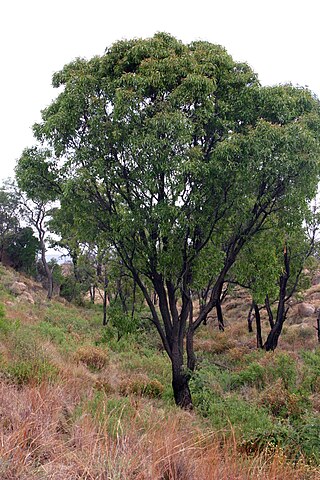
Faurea saligna is a graceful, semi-deciduous tree in the family Proteaceae. It grows to about 10 metres, or up to 20 metres under forest conditions. Found from tropical Africa south to the Transvaal, Swaziland and Natal, often in large communities on sandy soil and along stream beds.
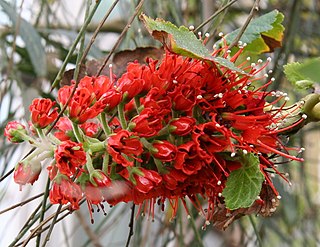
Greyia sutherlandii, also known as Natal bottlebrush, is a species of flowering plant in the familyFrancoaceae. It is native to South Africa, Eswatini, and Lesotho.
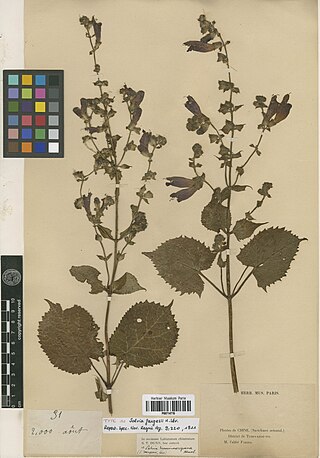
Salvia maximowicziana is a perennial plant in the family Lamiaceae. It is found growing on grasslands, forests, and forest edges in China, at 1,800 to 3,300 m elevation. It grows 10 to 90 cm tall, with circular-cordate to ovate-cordate leaves that are typically 3 to 8 cm long and 6 to 8 cm wide. The upper leaf surface is nearly smooth, or lightly covered with hairs, while the underside has glandular hairs on the veins.
Althenia australis is a species of aquatic plant in the family Potamogetonaceae. It is found in fresh to brackish waters in Australia. This species has been transferred from Lepilaena.

Markhamia obtusifolia is a species of plant in the family Bignoniaceae. It is found in Southern Africa.
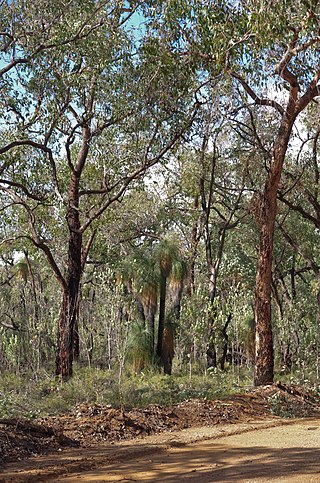
Xanthorrhoea drummondii, commonly known as grasstree or Drummond's balga, is a species of grasstree of the family Asphodelaceae. It is native to Western Australia.

Manilkara jaimiqui, commonly known as wild dilly, is a woody plant in the family Sapotaceae. It is native to tropical regions of North America, where it is found in the West Indies and south Florida. Its natural habitat is areas of coastal hammocks and pine rocklands.
Ophiobotrys zenkeri is a species of flowering plant in the family Salicaceae. It is a tree native to tropical Africa from Ivory Coast to Gabon and is the only member of the genus Ophiobotrys. Formerly classified in the Flacourtiaceae, phylogenetic analyses based on DNA data indicate that this species, along with its close relatives in the Asian genera Osmelia and Pseudosmelia, are better placed in a broadly circumscribed Salicaceae. Ophiobotrys differs from its close relatives in having 5 sepals, 5(-6) stamens, one divided style, and terminal inflorescences.

Wessel Marais B.Sc., M.Sc. (1929-2013) was a South African botanist and plant collector.
Nymphaea divaricata is a species of waterlily native to Angola, Zambia, and the Democratic Republic of the Congo.
















